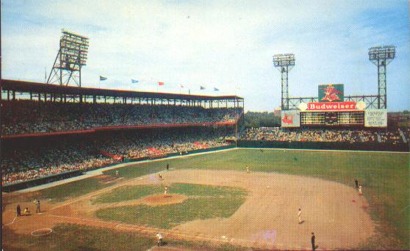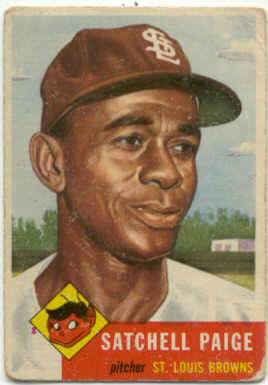|

|
| Sportsman's Park
- Home of the Browns |
American League 1902-1953
Today the Chicago Cubs are known as baseball's lovable losers.
Year after year (with a few exceptions) they finish in the lower half of their division, but still draw large crowds. Other
teams in history have also shared that distinction, like the expansion Mets of the early 1960s and the St. Louis Browns who
spent most of the first half of the 20th Century in the American League cellar.
The Browns history is filled
with legendary figures like Bill Veeck, Satchel Paige, Rogers Honrnsby, Branch Rickey, Pete Gray and Eddie Gaedel. Those men,
along with countless other less-memorable names, helped shape the unique history of the franchise which began play in 1901
as the Milwaukee Brewers, charter members of the American League. The team finished in last place, headed south to St. Louis,
and became the Browns (named after the Brown Stockings of the late 1880s). The team improved dramatically going 78-58 and
finishing in second place. Under owner Robert Hedges for their first 15 years, the Browns drew good crowds despite losing
more than 90 games six times, including three 100 loss campaigns.
In 1916 Hedges sold the team to Philip Ball, the
former owner of the St. Louis Terriers of the defunct Federal League. During Ball's tenure, which lasted until 1933, the Brown's
floundered. Of all Ball's mistakes, his largest was allowing young executive Branch Rickey to leave in favor of the cross-town
Cardinals.
Led by Hall of Famer George Sisler and OFs Ken Williams, "Baby Doll" Jacobson, and Jack Tobin, the Browns
nearly captured the 1922 AL Pennant going 93-61. They finished just a game behind the Babe Ruth-led Yankees. It would be the
lone highlight of the Ball regime.
Interestingly, the Browns and the Cardinals actually shared Sportsman's Park during
the 1920s. Cardinal's owner Sam Breadon persuaded Ball to let his team move in and sold it's park, Robison Field. Breadon
used the money from the sale to build up his farm system, a Branch Rickey innovation, which eventually produced a number of
star players that turned the Cardinals into champions.
Because of the dual tenants, Ball decided to expand the 18,000
seat Sportsman's Park to hold 30,000. He then confidently predicted their would be a World Series in St. Louis by 1926. Their
was indeed a World Series in St. Louis in 1926, but it was the Cardinals, not Ball's Browns who were in it. The Cards upset
the mighty Yankees and St. Louis, which had been a "Brown's town" officially became the "Cardinals town". The Browns, by the
way, finished 62-92 (29 games out of first) in 1926.

The Browns hit rock bottom in the late 1930s under the ownership
of Donald Barnes. In 1936 they drew just 80,922 fans for the entire season! From 1937 to 1939 they lost 108, 97, and 111 games.
During the decade the Browns winning percentage was .375 (an average of 95 losses per season), their high point was 1934 when
they went 67-85.
After the 1941 season, Barnes attempted to move the downtrodden franchise to Los Angeles, but had
bad timing. The owners' meeting designed to approve the sale was set for December 8, 1941 - the day after the attack
on Pearl Harbor. Understandably, the move was vetoed.
Things began to turn around during the early 1940s, under manager
Luke Sewell. By 1942, for the first time since 1928, the Browns were winners finishing 82-69. In 1944 the Browns actually
won the American League pennant, thanks to two home runs by Chet Laabs on the final day of the season against the Yankees.
The pennant was marred because of the war-depleted rosters and the Browns lost to the rival Cardinals in six games in the
World Series.
New ownership came in 1945, when Richard Muckerman and Bill and Charlie DeWitt took over. Unfortunately
for them, the team hit hard financial times and was forced to sell off it's bests players. The Browns even used one-armed
outfielder, Pete Gray, during that season.
In 1951 the colorful Bill Veeck bought the team and planned on running
the Cardinals out of town after owner Fred Saight was jailed because of income tax violations. It didn't happen. August Busch
came to the rescue and got the Cardinals back on track. Veeck pulled out all of the stops in an effort to raise attendance
for the Browns, trying dozens of stunts including "manage from the stands" day and sending midget Eddie Gaedel to the plate
to lead off a game (he walked). The other owners were less than amused by Veeck's antics and forced him to sell the team to
a group from Baltimore. They lost 100 games in 1953, their final in St. Louis.
The Browns headed east for the 1954
season and became the Baltimore Orioles. The Orioles went on to become a successful franchise and the Browns faded away into
history. Today, they are best remembered for being baseball's original loveable losers.
-David Zingler, May 2002
*FEEDBACK*
Simply Baseball Notebook
DISCLAIMER: All pictures are assumed to be in the public domain. No violation
of copyright is intended here. If one of the photos above is not in the public domain, please notify us and it will be removed.
|

